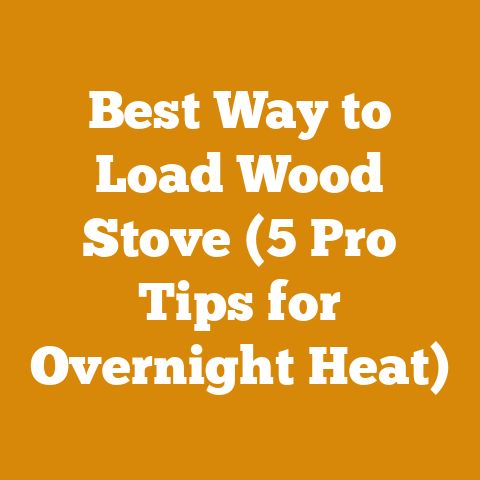Replacing Firebrick in Wood Stove (5 Pro Tips for Longer Stove Life)
Ever wondered if you could significantly extend the life of your trusty wood stove and boost its efficiency? You absolutely can, and one of the most crucial steps is often overlooked: replacing the firebrick.
Let’s face it, a wood stove is more than just a heat source; it’s a centerpiece, a comforting presence during those long winter nights. I’ve spent countless hours splitting wood, stacking cords, and tending the fire. Over time, I’ve learned that maintaining a wood stove isn’t just about cleaning the chimney; it’s about understanding its inner workings and giving it the care it deserves.
According to the U.S. Energy Information Administration, approximately 12 million households in the United States use wood as a primary or secondary heating source. This number highlights the importance of wood stoves, and consequently, the need for proper maintenance. Firebrick, the unsung hero of wood stoves, takes the brunt of the heat. When it cracks or crumbles, your stove’s efficiency plummets, and the risk of damage to the stove’s body increases.
In this guide, I’ll share my hard-earned wisdom and practical tips on replacing firebrick, ensuring your wood stove lasts longer and burns hotter. Think of it as a complete overhaul for your stove’s interior, a rejuvenation that will keep you warm for years to come. We’ll delve into the nitty-gritty details, from selecting the right firebrick to the step-by-step replacement process. Let’s get started!
Replacing Firebrick in Your Wood Stove: 5 Pro Tips for Longer Stove Life
Why Firebrick Matters: The Heart of Your Wood Stove
Before diving into the how-to, let’s understand the “why.” Firebrick is a type of refractory brick specifically designed to withstand high temperatures. They line the inside of your wood stove for a few key reasons:
- Heat Retention: Firebrick absorbs and radiates heat, creating a more consistent and efficient burn. This means less wood consumption and more warmth for your home.
- Protection: They shield the steel or cast iron body of your stove from direct flame, preventing warping, cracking, and premature failure.
- Combustion Efficiency: The heat reflected by the firebrick helps maintain a higher combustion temperature, leading to a cleaner and more complete burn. This reduces creosote buildup, a major fire hazard.
Data Point: Studies have shown that stoves with intact firebrick can be up to 30% more efficient than those with damaged or missing firebrick. That’s a significant saving on your firewood pile!
Key Concept: Refractory materials are heat-resistant substances used in high-temperature applications. Firebrick is a common example, but other materials like castable refractories are also used in stove construction.
Tip #1: Assess the Damage and Plan Your Attack
The first step is a thorough inspection. Grab a flashlight and carefully examine the firebrick inside your wood stove. Look for:
- Cracks: Hairline cracks are often normal, but large, gaping cracks are a sign of deterioration.
- Crumbling: If the firebrick is falling apart or easily chipped, it’s definitely time for replacement.
- Missing Pieces: Any missing firebrick should be replaced immediately to prevent damage to the stove body.
- Warping: Although less common, warping indicates extreme heat exposure and may necessitate replacing the affected firebrick.
Personal Story: I once neglected a cracked firebrick for too long. The heat eventually caused a minor warp in the stove’s back panel, requiring a costly repair. Lesson learned: address firebrick issues promptly!
Actionable Step: Take photos of the damaged firebrick. These will be helpful when ordering replacements.
Unique Insight: Pay attention to the pattern of damage. Is it concentrated in one area? This could indicate a hot spot caused by improper airflow or burning specific types of wood.
Planning Your Attack:
- Identify the Firebrick Type: Most wood stoves use standard-sized firebrick (typically 9″ x 4.5″ x 1.25″), but it’s crucial to confirm the dimensions in your stove’s manual or by measuring the existing brick.
- Count the Bricks: Determine the number of firebricks you need to replace. It’s always a good idea to order a few extra, just in case.
- Determine the Layout: Note the layout of the firebricks, including any specific angles or cuts. Some stoves use custom-cut bricks for a precise fit. A simple sketch can be invaluable.
Cost Considerations: Firebrick typically costs between $3 and $10 per brick, depending on the size and quality. Factor in the cost of refractory mortar if you plan to cement the bricks in place.
Tip #2: Choosing the Right Firebrick: Material Matters
Not all firebrick is created equal. Selecting the right type is critical for optimal performance and longevity. Here’s a breakdown of the common types:
- Standard Firebrick: Made from fireclay, these are the most common and affordable option. They’re suitable for most wood stoves used for residential heating.
- High-Alumina Firebrick: These contain a higher percentage of alumina, making them more resistant to high temperatures and thermal shock. They’re a good choice for stoves that are frequently used at high heat or for burning coal.
- Insulating Firebrick: These are lighter and less dense than standard firebrick, providing better insulation. They’re often used in specialized applications where heat retention is less important than insulation.
Data Point: High-alumina firebrick can withstand temperatures up to 3,000°F (1,650°C), while standard firebrick typically handles around 2,500°F (1,370°C).
Actionable Tip: Consult your wood stove’s manual to determine the recommended type of firebrick. If the manual is unavailable, opt for standard firebrick unless you have specific needs for higher heat resistance.
Unique Insight: Consider the type of wood you burn. If you primarily burn hardwoods like oak or maple, which generate higher heat, high-alumina firebrick might be a worthwhile investment.
Where to Buy:
- Local Stove Shops: These are excellent sources for firebrick and expert advice.
- Hardware Stores: Many hardware stores carry standard firebrick.
- Online Retailers: Online retailers offer a wide selection of firebrick, often at competitive prices. Just be sure to check shipping costs.
Tool Selection:
- Tape Measure: For accurate measurements.
- Camera: To document the existing layout.
- Notepad and Pen: For sketching the layout and noting any special cuts.
Tip #3: The Replacement Process: A Step-by-Step Guide
Now for the hands-on part. Here’s how to replace the firebrick in your wood stove:
Step 1: Safety First!
- Let the Stove Cool Completely: Ensure the stove is completely cold before starting any work.
- Wear Gloves and Eye Protection: Protect your hands and eyes from dust and debris.
- Work in a Well-Ventilated Area: Firebrick dust can be irritating to the lungs.
Step 2: Remove the Old Firebrick
- Gently Pry Out the Bricks: Use a flathead screwdriver or a small pry bar to carefully remove the old firebrick. Be patient and avoid excessive force, which could damage the stove body.
- Clean the Area: Use a wire brush or a scraper to remove any old mortar or debris from the stove walls. A clean surface is essential for proper adhesion of the new firebrick.
Step 3: Prepare the New Firebrick (If Necessary)
- Cutting Firebrick: If you need to cut firebrick to fit, use a masonry saw or a wet saw. These tools are designed to cut through hard materials without creating excessive dust.
- Smoothing Edges: Use a rubbing brick or a file to smooth any rough edges. This will help prevent the firebrick from chipping or cracking.
Step 4: Install the New Firebrick
- Dry Fit: Before applying mortar, dry fit the new firebrick to ensure a proper fit. Make any necessary adjustments at this stage.
- Apply Refractory Mortar (Optional): If you choose to use mortar, apply a thin layer to the back and sides of the firebrick. This will help secure the bricks in place and create a tighter seal.
- Position the Firebrick: Carefully position the firebrick in the stove, pressing it firmly into place.
- Remove Excess Mortar: Use a damp sponge to wipe away any excess mortar.
Step 5: Curing the Mortar (If Used)
- Follow Manufacturer’s Instructions: The curing process varies depending on the type of mortar used. Follow the manufacturer’s instructions carefully.
- Gradual Heat: Typically, you’ll need to gradually heat the stove over several days to allow the mortar to cure properly. Avoid burning a hot fire during the curing process.
Step 6: Final Inspection
- Check for Gaps: Inspect the installed firebrick for any gaps or cracks. Fill any gaps with mortar.
- Ensure Stability: Make sure the firebrick is securely in place and won’t shift during use.
Case Study: A friend of mine, a seasoned woodworker, decided to replace the firebrick in his antique wood stove. He meticulously measured each brick, cut them with precision using a wet saw, and applied refractory mortar with the care of a surgeon. The result? A perfectly restored stove that burned like new. His attention to detail made all the difference.
Troubleshooting:
- Firebrick Too Tight: If the firebrick is too tight, gently tap it into place with a rubber mallet. Avoid using excessive force, which could crack the brick.
- Mortar Not Adhering: Ensure the surfaces are clean and dry before applying mortar. Use a high-quality refractory mortar specifically designed for wood stoves.
- Cracks Appearing After Curing: This could indicate that the mortar was not properly cured or that the firebrick is under stress. Consult a professional if the cracks are significant.
Tip #4: Maximizing Firebrick Lifespan: Prevention is Key
Replacing firebrick is a necessary maintenance task, but you can extend their lifespan with a few simple practices:
- Burn Seasoned Wood: Burning green or wet wood creates excessive creosote and moisture, which can damage firebrick. Always burn properly seasoned wood with a moisture content of 20% or less.
- Avoid Overfiring: Overfiring your stove can cause extreme heat, which can lead to premature firebrick failure. Follow the manufacturer’s recommendations for optimal burning temperatures.
- Proper Airflow: Ensure your stove has adequate airflow. Restricted airflow can lead to incomplete combustion and higher temperatures, stressing the firebrick.
- Gentle Loading: Avoid throwing large logs into the stove, which can crack or chip the firebrick. Load wood gently and evenly.
- Regular Cleaning: Clean your stove regularly to remove ash and debris, which can trap moisture and corrode the firebrick.
Data Point: Wood seasoned for 6-12 months has a moisture content of around 20%, while freshly cut wood can have a moisture content of 50% or higher.
Key Concept: Seasoned wood is wood that has been allowed to dry, reducing its moisture content. This makes it burn more efficiently and cleanly.
Actionable Tip: Invest in a moisture meter to accurately measure the moisture content of your firewood.
Unique Insight: Consider using a wood stove thermometer to monitor the burning temperature. This will help you avoid overfiring and extend the life of your firebrick.
Firewood Preparation Best Practices:
- Split Wood Promptly: Split wood dries faster than whole logs.
- Stack Wood Properly: Stack wood in a single row, allowing for good airflow.
- Cover the Top: Cover the top of the wood stack to protect it from rain and snow.
- Elevate the Stack: Elevate the wood stack off the ground to prevent moisture absorption.
Tip #5: Maintaining Your Wood Stove: A Holistic Approach
Replacing firebrick is just one piece of the puzzle. A well-maintained wood stove will not only last longer but also burn more efficiently and safely. Here are some additional maintenance tasks:
- Chimney Cleaning: Clean your chimney at least once a year, or more frequently if you burn a lot of wood. Creosote buildup is a major fire hazard.
- Gasket Replacement: Replace worn or damaged door and glass gaskets to maintain a tight seal and prevent air leaks.
- Stove Pipe Inspection: Regularly inspect your stove pipe for signs of corrosion or damage. Replace any damaged sections immediately.
- Baffle Inspection: Inspect the baffle (if your stove has one) for cracks or warping. Replace it if necessary.
- Ash Removal: Remove ash regularly to prevent buildup and ensure proper airflow.
Data Point: The National Fire Protection Association (NFPA) recommends that chimneys be inspected annually and cleaned as needed.
Personal Story: I once neglected to clean my chimney for two years. The creosote buildup was so thick that it nearly caused a chimney fire. It was a scary experience that taught me the importance of regular maintenance.
Actionable Tip: Create a maintenance schedule for your wood stove and stick to it. This will help you catch problems early and prevent costly repairs.
Resource Management Tips:
- Source Firewood Locally: Support local firewood producers and reduce transportation costs.
- Recycle Ash: Wood ash is a valuable source of nutrients for your garden.
- Proper Disposal: Dispose of old firebrick and other stove components responsibly.
Common Pitfalls to Avoid:
- Using the Wrong Type of Firewood: Avoid burning treated wood, painted wood, or construction debris. These materials can release harmful chemicals and damage your stove.
- Ignoring Warning Signs: Pay attention to any unusual noises, smells, or smoke coming from your stove. These could indicate a problem that needs to be addressed.
- DIY Repairs Without Knowledge: If you’re not comfortable performing a repair yourself, hire a qualified professional.
Next Steps and Additional Resources
Congratulations! You’ve now armed yourself with the knowledge and skills to replace the firebrick in your wood stove and keep it running smoothly for years to come. Here are some additional resources to help you on your journey:
- Wood Stove Manufacturers’ Websites: These websites often provide valuable information about maintenance and repair.
- Online Forums and Communities: Connect with other wood stove owners and share tips and experiences.
- Local Stove Shops: These shops can provide expert advice and sell replacement parts.
- Chimney Sweeping Services: Hire a professional chimney sweep to clean and inspect your chimney.
- Firewood Suppliers: Find a reputable firewood supplier in your area.
- Moisture Meter Suppliers: Purchase a moisture meter to accurately measure the moisture content of your firewood.
Suppliers of Logging Tools and Equipment:
- Stihl: A leading manufacturer of chainsaws, logging tools, and safety equipment.
- Husqvarna: Another top brand known for its high-quality chainsaws and forestry equipment.
- Oregon Tool: A manufacturer of chainsaw chains, guide bars, and other logging accessories.
- Bailey’s: A supplier of logging tools, equipment, and safety gear.
Drying Equipment Rental Services:
- While specialized drying equipment for firewood is less common for rental, consider:
- Industrial Fan Rental: To increase airflow around stacked wood.
- Dehumidifier Rental (Large Capacity): For enclosed drying spaces.
Remember, maintaining your wood stove is an ongoing process. By following these tips and staying vigilant, you can enjoy the warmth and comfort of your wood stove for many years to come. So, get out there, get your hands dirty, and keep that fire burning bright!






